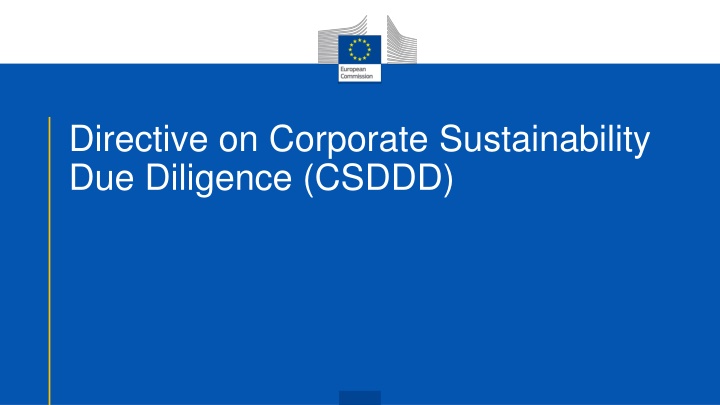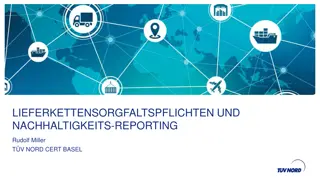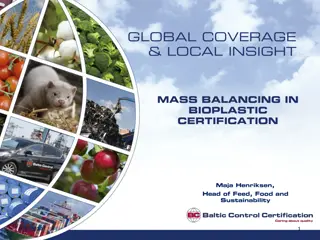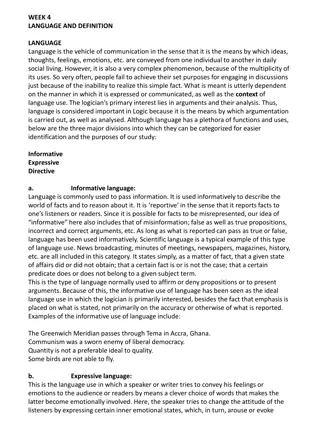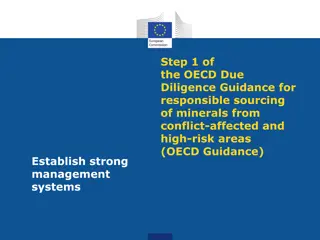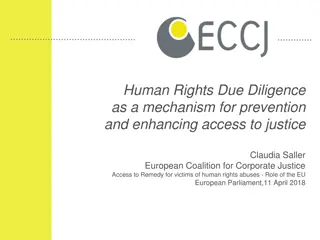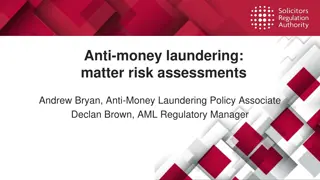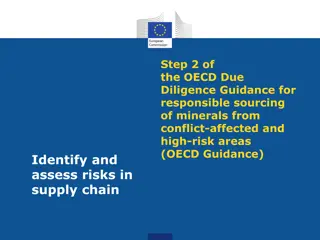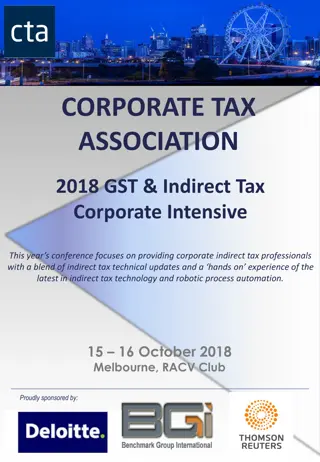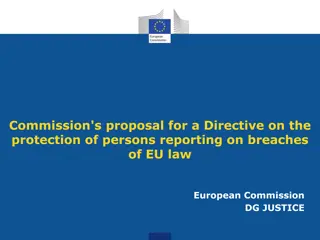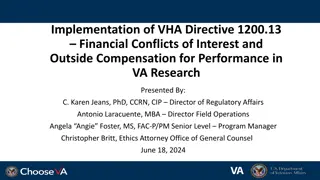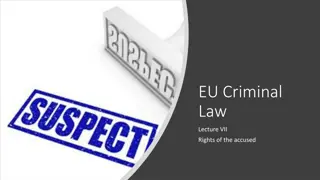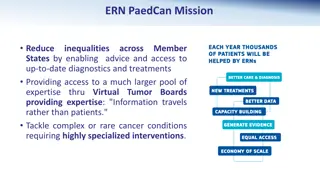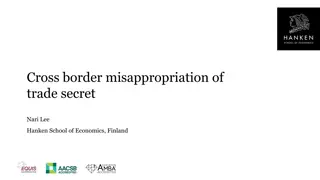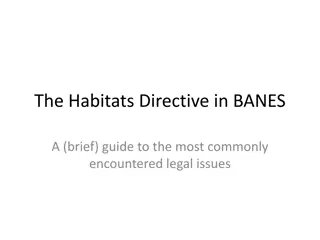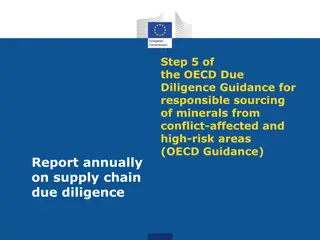Corporate Sustainability Due Diligence Directive
Duty for companies to identify and address adverse human rights and environmental impacts within operations, subsidiaries, and chain activities. It emphasizes a green and just transition, aligning with international guidelines for responsible business conduct and human rights protection.
Download Presentation

Please find below an Image/Link to download the presentation.
The content on the website is provided AS IS for your information and personal use only. It may not be sold, licensed, or shared on other websites without obtaining consent from the author.If you encounter any issues during the download, it is possible that the publisher has removed the file from their server.
You are allowed to download the files provided on this website for personal or commercial use, subject to the condition that they are used lawfully. All files are the property of their respective owners.
The content on the website is provided AS IS for your information and personal use only. It may not be sold, licensed, or shared on other websites without obtaining consent from the author.
E N D
Presentation Transcript
Directive on Corporate Sustainability Due Diligence (CSDDD)
WHAT? Duty for companies in scope to identify and address potential and actual adverse human rights and environmental impacts in their own operations, those of their subsidiaries and, where related to their chain(s) of activities, those of their business partners 2
WHY? Green and just transition OECD Guidelines for Multinational Enterprises (2011) and Due diiligence guidance for responsible business conduct ILO Tripartite Declaration of Principles concerning MNEs and social policy (1977) UN Guiding Principles on Business and Human Rights (2011) Calls from co-legislators Stakeholder support Protecting human rights and the environment, including in value chains Sustainability transition: making the economy more competitive and resilient Ensuring level playing field in the Single Market 3
PERSONAL SCOPE Anti-circumvention / Level playing field PERSONAL SCOPE 1. Groups of companies ultimate parent company of group reaching the thresholds on consolidated basis For each of the last two consecutive financial years > 1 000 employees and > 450 million net worldwide turnover EU COMPANIES: LARGE LLCs & PARTNERSHIPS 2. Franchising or licensing agreements royalties more than 22.5 million AND net turnover > 80 million ww/in the EU (either alone or as ultimate parent company of a group) > 450 million of net turnover in the EU (=link to the EU market) NON-EU COMPANIES: COMPARABLE FORM Duty to designate and notify representative empowered to cooperate with supervisory authorities Companies outside scope (in particular SMEs): no duties, no public enforcement/sanctions and no liability under the Directive 4
MATERIAL SCOPE (I): ADVERSE IMPACTS Human rights impacts Comprehensive list of human rights (ensured by recognized international conventions) (Annex, Part I, Section 1) Additional human rights protected by list of recognized international conventions (Annex, Part I, Section 2) Environmental impacts List of prohibitions and obligations set out in intl environmental instruments (Annex, Part II) exhaustive Environment-related human rights (Annex, Part I, Section 1, points 15, 16)
MATERIAL SCOPE (II): CHAIN OF ACTIVITIES UPSTREAM Activities of a company s upstream business partners related to the production of goods or the provision of services by that company Including design and development, sourcing (extraction, supply of raw materials, manufacture), transport and storage DOWNSTREAM Activities of a company s downstream business partners related to the distribution, transport and storage of a product of that company Only where the business partner carries out those activities for the company or on behalf of the company Not: financial services (COM to evaluate within 2 years need for due diligence requirements tailored to financial sector)
WHICH DUTIES? (I) CORPORATE DUE DILIGENCE General principles: Risk-based approach Appropriatemeasures : effective, commensurate & reasonably available, considering all circumstances (incl. level of involvement, ability to influence and risk factors) Integrating due diligence (DD) intocompany spolicies and risk management systems, specific DD policy (including code of conduct) Identifying, assessing and, where necessary, prioritizing actual or potential adverse impacts Broad mapping in-depth assessment using appropriate resources (incl. independent reports); prioritization of information from business partners at the level of the chain of activities where adverse impacts are most likely to occur Prioritization based on severity and likelihood of impacts (where not all can be addressed at the same time to their full extent) 7
WHICH DUTIES? (II) CORPORATE DUE DILIGENCE Taking appropriate measures to prevent/mitigate potential impacts or bring to an end/minimize the extent of actual impacts Prevention/corrective action plan (in complex cases), contractual assurances on fair & reasonable terms, (non-)financial investments, modifications to strategies/operations (incl. design, purchasing and distribution practices), support for SMEs (incl. capacity building, training, financial support), collaboration with other entities In case of actual adverse impact that company (jointly) caused: also remediation Only as a last resort: temporary suspension or termination of the business relationship (only in case of severe impacts); prior assessment if adverse impact of suspension/termination more severe than the adverse impact to be addressed Meaningful stakeholder engagement (only) at certain DD stages, complaints procedure (for affected persons, trade unions, envtl CSOs) and notification mechanism (incl. anonymously) Monitoring the effectiveness of due diligence and publicreporting 8
WHICH DUTIES? (III) CLIMATE CHANGE TRANSITION PLAN Transition plan for climate change mitigation All companies, incl. financial sector To ensure compatibility of business model/strategy with limiting global warming to 1.5 C in line with Paris Agreement / targets of European Climate Law (incl. net zero by 2050) Minimum content: incl. time-bound targets (incl. absolute GHG reduction targets for Scope 3, where appropriate), decarbonization levers, key actions and financing Duty to adopt, put into effect and update every 12 months; implementation is obligation of means ( best efforts ) Adoption duty deemed to be fulfilled in case of compliance with CSRD No liability under the Directive 9
ENFORCEMENT Administrative supervision Civil liability Independent supervisory authorities with adequate investigatory powers (incl. inspections) and enforcement powers (incl. injunctions and penalties), acting based on complaints or on their own motion Where harm to a natural or legal person s legal interests protected under national law is caused by intentional or negligent failure to comply with DD obligations under Arts 10, 11 Company not liable if the damage is caused only by business partner(s) in its chain of activities European Network of Supervisory Authorities to ensure EU-level coordination and cooperation Access to justice safeguards: (i) limitation period of at least 5 years, (ii) representative action, (iii) power for courts to require disclosure of evidence, (iv) injunctive powers for courts, (v) no prohibitive costs Proportionate and dissuasive penalties, incl. in the form of fines (minimum cap 5% of the company s net worldwide turnover) 10 10
Impacts in a nutshell Human rights protection, including better working conditions, living wages and income Protection of the environment (as part of the protection of individuals & as a public good) Empowerment of local communities and other stakeholders (meaningful engagement with companies in scope) Increased competitiveness of companies (resource efficiency, access to finance, protection against risks, innovation, etc.) + support and capacity- building for companies in value chains Driving the sustainability transition (incl. climate change mitigation) 11
Helping companies comply Burden limitation for companies in scope Safeguards to limit trickle-down effect on SMEs Sharing of resources and info within groups and with other legal entities Requesting information directly from where impact is most likely to occur Risk-based approach, incl. for in-depth assessment Adaptation of purchasing practices Digital tools and technologies Civil liability limitation Targeted and proportionate support, incl. financial Fair, reasonable and non-discriminatory contract terms Investment duty Risk based approach / prioritisation Industry & multi- stakeholder initiatives, independent third-party verification No passing-on of costs of verification, possibility to re-use reports Limitation of reporting requirements Information and capacity-building (Financial) support (MS, EU) Termination as a last resort 12
SUPPORT (I) How to conduct due diligence, in particular identification, prioritization, adaptation of purchasing practices, responsible disengagement, remediation, engagement with stakeholders Climate transition plans Sector-specific guidance Assessment of risk factors, incl. those associated with conflict- affected and high-risk areas Guidelines Data/information sources for carrying out DD duties, guidance about digital tools to facilitate and support compliance Ways how to share resources and information Information for stakeholders on how to engage Model contract clauses
SUPPORT (II): Accompanying measures COM can complement to support DD in EU and abroad Financial support for SMEs Dedicated websites, platforms or portals MS Stakeholder support for exercise of rights Accompanying measures COM facilitation of initiatives, guidance on fitness criteria and how to monitor the accuracy, effectiveness and integrity of third- party verification COM Single Helpdesk Industry & multi- stakeholder initiatives and independent third- party verification Company 14
Transposition/application periods (Article 37) Entry into force (24 July 2024) and transposition into national law (26 July 2026) Entry into application (x years after entry into force): EU: +5 000 employees, 1 500 million turnover (worldwide) 3 years EU: +3 000 employees, 900 million turnover (worldwide) 4 years Third-country: 1 500 million turnover (EU) 3 years Third-country: 900 million turnover (EU) 4 years All other companies in scope 5 years 15
RESOURCES Text of the Directive: https://eur-lex.europa.eu/legal- content/EN/TXT/?uri=OJ:L_202401760 Frequently Asked Questions: https://commission.europa.eu/document/download/7a3 e9980-5fda-4760-8f25- bc5571806033_en?filename=240719_CSDD_FAQ_final.p df 16
